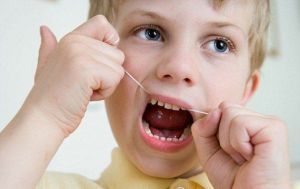 Dental floss( floss) is an additional means of oral hygiene. It is used for cleaning the lateral surface of the tooth and the space between the teeth from plaque( accumulation of bacteria) and food residues.
Dental floss( floss) is an additional means of oral hygiene. It is used for cleaning the lateral surface of the tooth and the space between the teeth from plaque( accumulation of bacteria) and food residues.
The toothbrush can not boast cleaning these hard-to-reach places. The main purpose of the application of dental floss is the prevention of caries and periodontal diseases.
Content
- Knowledge
- Knowledge
- Floss rules
- Visual aid
- Special features for use with brackets
- The presence of crowns is not a problem
- Possible problems
- To be able to use little - choose what you need
Knowledge is the power
Knowing how to use the dentalthread, gives a guarantee that cleaning will be carried out qualitatively and painlessly.
Improper use of floss can lead to pain and injury to the gums, and, consequently, to bleeding and diseases.
Floss rules
Only regular use of floss will give tangible results in the prevention of caries and periodontal diseases. In case of high
gum sensitivity, it is necessary to use at least once a day( before and after the evening dentifrice) but the ideal solution - after each meal.
Another good option is to brush your teeth using floss 2 times a day( morning and evening).Use the thread best before brushing with a toothbrush.
So, how to properly use the dental floss with the maximum effect:
- First you need to take a cassette with a thread. then pull about 40 cm of floss ( if you have previously
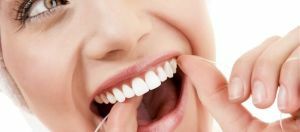 did not use this facility and are afraid to make a mistake in length, it is best to use a ruler).
did not use this facility and are afraid to make a mistake in length, it is best to use a ruler). - After this, one end of the floss is wound on the middle or index finger of the right hand, the other end is wound on the same finger of the left hand. This procedure must be done so that one finger only fixed dental floss, and the bulk of it was wound on another finger .
- There should be a length of thread about 5 centimeters between the fingers .This distance is sufficient for convenient cleaning of teeth and spaces between them. It is necessary to securely fix the thread between the thumb of the right hand and the index finger of the left.
- Then you need a good pull thread , open his mouth wide and introduce it into the interdental space. It is necessary to do this carefully, so as not to injure the gum. Movements should be easy and smooth, do not make great efforts.
- Press the thread to the side of the tooth and do the movements from top to bottom on this surface( 6-8 movements are enough).Floss
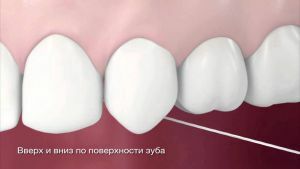 should be slightly wound beyond the gum line. This manipulation allows you to remove plaque and food remnants from under the gums. The thread must be pressed to the tooth and move towards its cutting surface. First, move back and forth, and then up and down.
should be slightly wound beyond the gum line. This manipulation allows you to remove plaque and food remnants from under the gums. The thread must be pressed to the tooth and move towards its cutting surface. First, move back and forth, and then up and down. - All the lower and upper teeth of the are cleaned. To prevent bacteria from transferring from one tooth to another, each new tooth should be cleaned with a new floss site.
Visual aids
deal with the fact how to use dental floss to explore all the nuances of a painless application, help videos and photos:
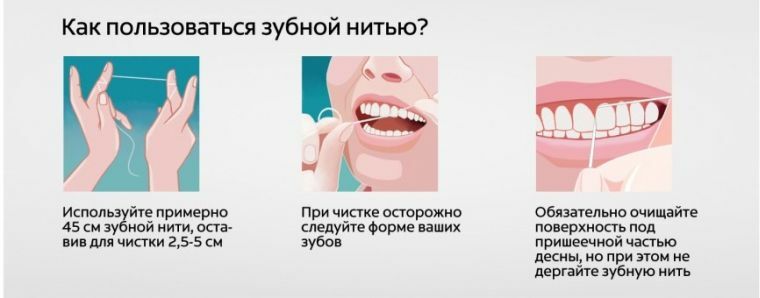
Features of use in the presence of
braces If you have braces or orthodontic prosthesis is particularly important proper brushing technique( avoid contact with the thread onbrackets).
A special floss is used that combines the properties of several types of threads. Its one end is narrow, not fissile. It gives the ability of the thread to easily penetrate into the interdental space. The other end is fibrous and wider.
This thread perfectly removes the remnants of food from prostheses and braces. The combination of these parts in one thread gives the product a high efficiency.
In addition, you should buy a machine for the thread( flosser) - a device that has a hook at one end, and on the other - a loop. To use the device, it is necessary to pass through a loop a length of a string 18 cm long.
Then you need to insert the pointed part of the flosser under the braces base and pull so that the thread passes right under it. Once the floss is in place, you can start cleaning according to general principles.
Visual step-by-step photography:
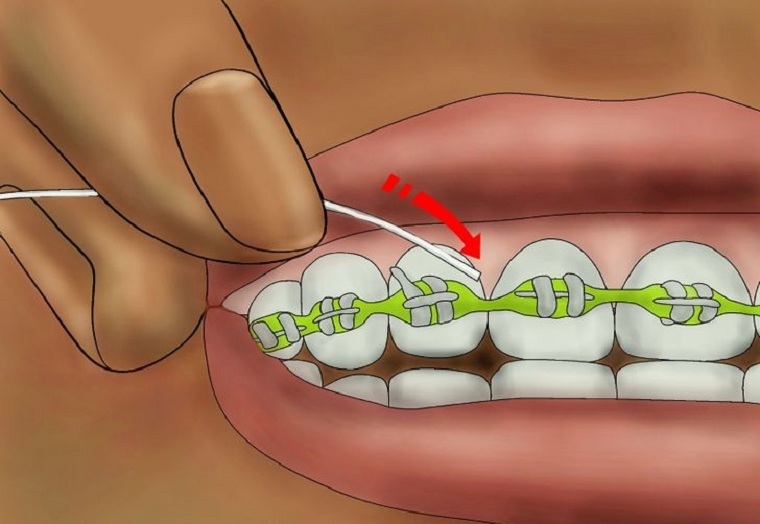
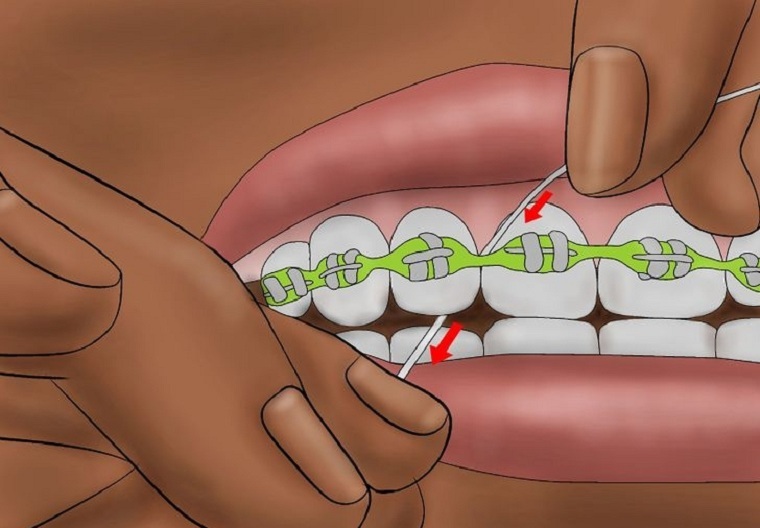
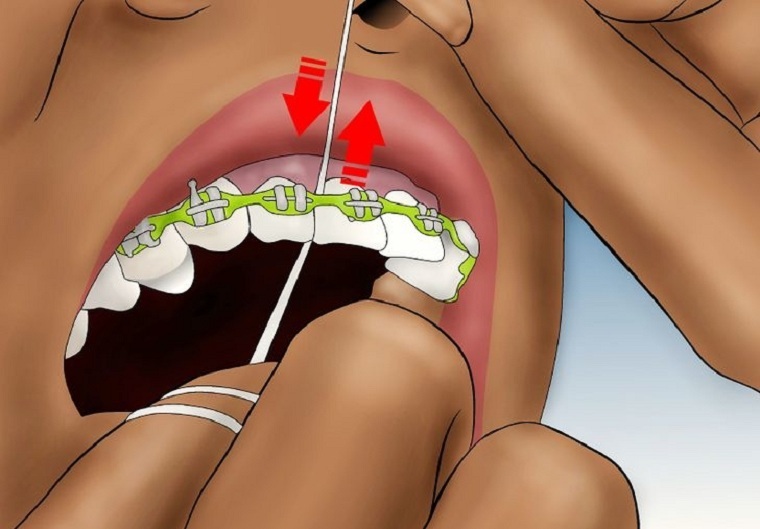
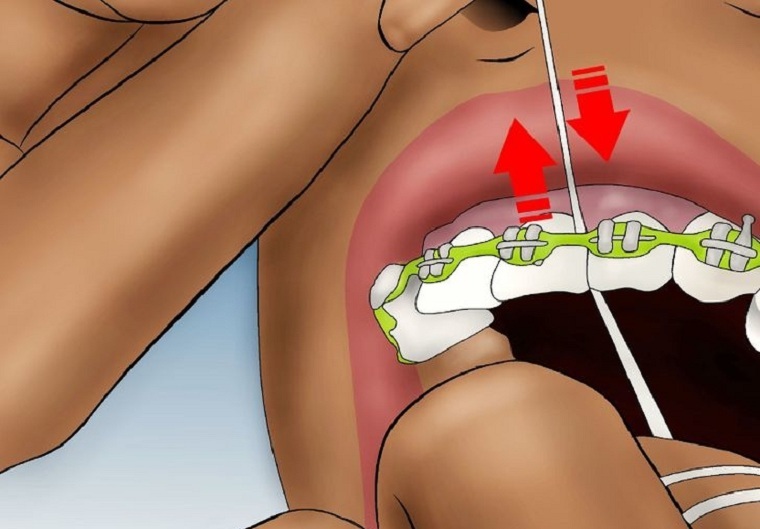
Presence of crowns - not a problem
In the presence of crowns of cermets, you must use superfloss. This is a unique floss, which includes:
- hard fiber resembling a fishing line;
- conventional dental floss;
- is a nylon fiber that can be highly stretched.
Thanks to this structure, the efficiency of the superfloss is approximately 65% higher than the efficiency of the conventional thread.
Possible problems
First of all, the thread should not be torn when removed from the interdental space.
The reasons for the gap may be:
- low quality of the product;
- caries on the contact surface of the teeth;
- a poor-quality prosthesis or a seal that has a chip or rough surface.
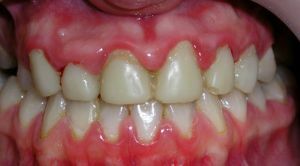 With ineffective and very frequent use of floss, it is possible to injure the gums. On their surface, wounds( sometimes deep) are formed, which slowly heal. In this case, microorganisms from the teeth can penetrate into the gum tissue through the wound surface, provoking serious complications: gingivitis, periodontitis, stomatitis.
With ineffective and very frequent use of floss, it is possible to injure the gums. On their surface, wounds( sometimes deep) are formed, which slowly heal. In this case, microorganisms from the teeth can penetrate into the gum tissue through the wound surface, provoking serious complications: gingivitis, periodontitis, stomatitis.
With inept use, the dental floss can get stuck between the teeth, in this case, do not panic, but with gentle, but persistent movements, pull at one end of the floss.
At the initial stages of using flossing, there is often a slight bleeding of the gums. This is normal: the body adapts to a new kind of cleansing. Bleeding disappears, usually after one week of cleansing.
To prevent bacteria from entering the gums, rinse the mouth with solutions of disinfectants. If after a week of using the gum thread, still bleed, you need to stop using the product and contact the dentist.
Diseases in which use of this tool is strictly prohibited:
- periodontitis;
- extensive caries with the formation of cavities;
- parodontosis.
Know how to use a little - choose what you need
Choose a dental floss is just as important as knowing how to use it.
The flosses are circular in shape of the cross-section( they are recommended for people with broad interdental lumens) and flat( wide threads intended for patients with tightly fitting teeth).
According to the material for the manufacture of threads for teeth there are:
- silk - have a small thickness, excellent cleaning properties, but low strength;
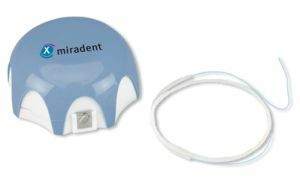
- Teflon - more expensive than nylon, glide well in the teeth, penetrate into narrow interdental spaces;
- nylon -( defibration).
Synthetic fiber threads( Teflon and nylon) have almost entirely replaced silk products.
Waxed and non-waxed dental flosses are extracted from the surface treatment. The purifying power of untested flosses is much better.
This is due to the fact that during operation they are broken, thereby providing greater contact with the tooth surface. Wax floss is not exfoliated, suitable for cleaning densely located teeth.
By impregnation, we can distinguish impregnated threads( curative and preventive) and threads without impregnation( preventive).Various substances are used for impregnation:
- chlorhexidine ( antiseptic action) - does not allow bacteria to enter the gum when it is injured;
- sodium fluoride ( anticaries effect);
- menthol ( aromatic additive) - gives freshness to breathing.
For the purpose of the thread there are:
- for individual use of ;
- professional threads ( designed for use in a dental office).
Inattention to oral hygiene can cause complications: caries, periodontal disease. Proceeding from this, it is important to follow the rules for the care of teeth and mouth in general.
The toothbrush can not cope with the removal of sticky deposits and food residues from the interdental space. With the help of a brush it is also impossible to clean the contact surface of the tooth, and in fact it occupies about 40% of the area of the entire tooth surface.
Only floss can solve these problems. It will be correct to say this: you only brush your teeth half if you do not use dental floss.
